
In September of 2017, I received slightly over $100K from my former employer, representing the commuted value of my pension plan. I decided to invest 100% of this money in dividend growth stocks.
Each month, I publish my results on those investments. I don’t do this to brag. I do this to show my readers that it is possible to build a lasting portfolio during all market conditions. Some months we might appear to underperform, but you must trust the process over the long term to evaluate our performance more accurately.
Performance in Review
Let’s start with the numbers as of November 2nd, 2022 (after the bell):
Original amount invested in September 2017 (no additional capital added): $108,760.02.
- Portfolio value: $198,208.97
- Dividends paid: $4,445.06 (TTM)
- Average yield: 2.24%
- 2021 performance: +16.78%
- SPY= 28.75%, XIU.TO = 28.05%
- Dividend growth: +3.14%
Total return since inception (Sep 2017-Nov 2022): 82.20%
Annualized return (since September 2017 – 62 months): 12.31%
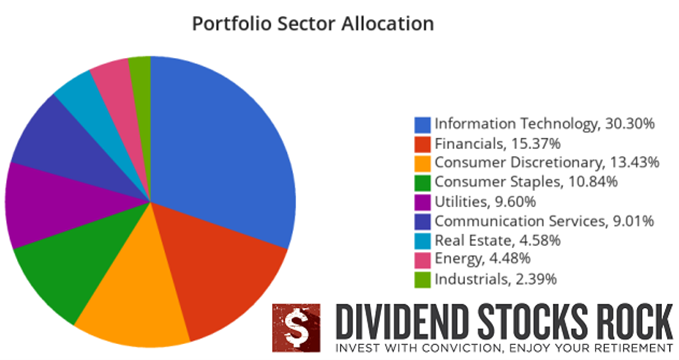
Sector allocation calculated by DSR PRO.
A Tale of Shiny Objects
I may surprise a few of you with today’s market remarks. I don’t talk too much about my speculative plays because they may often be taken as “the only trade you should be making” that month, while the opposite is true. Most of us are attracted by the gains from our investments. Speculative plays have this unique particularity: their narrative is quite seducing, and many investors forget to do their due diligence before jumping in the boat.
“Oh, I read this article or heard this guy talking about ABC, he’s very bullish and I bought some for myself”.
Dangerous behavior. Therefore, I’ve decided to share the time I invested in cryptocurrencies for this chronicle. Before you become concerned that I have secretly traded cryptos and abandoned dividend growth investing, please note that at no time have my speculative plays in the crypto world exceeded 3% of my total portfolio. That is because I never considered these investment candidates for my long-term portfolio.
I first decided to invest money in crypto by curiosity rather than by cupidity. I wanted to learn how this new technology worked and I recognized the hype around them could be an interesting speculative play. Again, a speculative play is an “in and out” where you capture (or believe you will capture) a market inefficiency. In this case, I was convinced it was another tulip story, but I could turn around and sell fast enough to cash some profit like a bandit.
A tulip story?
I’m pretty sure you know your history, but to ensure we are on the same page, what I call a tulip story is in reference to the Dutch Tulip Mania that happened in the 17th century. God knows why many investors started to trade tulip bulbs on numerous Dutch exchanges. Those trades received a lot of hype as many speculators thought they could jump in, buy bulbs, and then sell them to the next guy jumping into the wave at a higher price. In the end, it’s always the same story. You buy a non-cash-flow-producing asset thinking you can wait and sell it at a higher price to someone else. Most of the time, “someone else” is just a guy like you thinking the same thing. It’s pretty much like playing musical chairs. When the music stops, the market crashes because there are no more buyers.
Making money with bitcoin like a villain
Regardless of the technology behind the cryptocurrencies, bitcoins are like tulip bulbs: they are non-cash-flow-producing assets. Their only value is based on supply and demand. Since the supply part is limited to the amount of bitcoin that could exist globally, many have said it has an intrinsic value. Keep in mind that there is also a limited number of drinkable water on earth, and we are far from paying $50,000 a liter.
So, following the tulip narrative, I decided to do a quick in and out in the bitcoin world toward the end of 2020. The idea was relatively simple: use some speculative money, get in, follow it closely and protect my profit, if any.
I must admit, I got lucky. I bought a closed-end fund that became an ETF, if I remember correctly, toward the end of 2020 when the BTC traded around $20,000. It kept on surging until it reached $40,000 rapidly in January before going back down a little. I followed the price and decided to take my profit again if BTC went above $40,000 again. I didn’t have to wait very long…
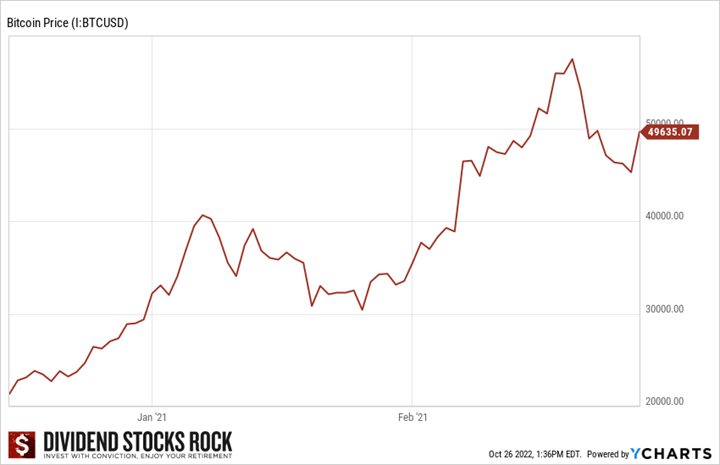
Since my goal wasn’t to be a “holder” (those who held forever), I cashed my profit and ran. That was my first experience in the crypto world. It was fun, I made money, but this wasn’t the real deal. I played with a packaged investment product, not real technology. I wanted to get to the next level now that I had more money.
Running after my coins
Months passed in 2021 and “new opportunities” appeared almost daily. One of my good friends was making thousands of dollars almost instantly with basic graphic images called NFTs (Non-Fungible Token). Those images were sold as incredibly special, but besides the fact that you owned 100% of the right (like when you buy a Rembrandt), they were nothing but a jpeg digital picture. Again, the technology behind NFTs is very smart. It enables you to create a smart contract that can be traded and keep its particularities. Imagine that your house registration could be put into an NFT.
No more lawyers, title research, or fees linked to a transaction. You could buy or sell a property within seconds and become the owner. A small fee (imagine 1%) would be paid to the constructor or previous owner.
After a few months, my friend (the same one making a small fortune with crypto and NFT) introduced me to a project he thought I might be interested in. The project was called “StepN” if you want to research it. The concept was quite interesting. StepN is defined as a Web3 lifestyle app where you can earn tokens by walking, jogging, or running. The idea is quite simple:
StepN is a sports application that tracks your movements through GPS. It pays you tokens (its own cryptocurrency) each time you use it for a walk or a run. You can appreciate my interest as I run 4 times a week and now, I would get paid in cryptocurrency to keep up with a healthy habit. It’s a win-win situation. The token you earn could then be exchanged for “real currencies” such as U.S. dollars. When I stepped in the project (pun intended) on April 21st, a token was worth about $4.

Long story short, you could earn about 8-10 tokens for each 10-minute run. Therefore, at $4, you could make between $32 and $40 in 10 minutes. Mike, I hope you ran 3 hours per day!!!!
However, it’s not that simple.
You must buy an image of a shoe (NFT) to earn tokens. That NFT is linked to your account, which is how you earn tokens. You can boost your shoes, upgrade them, repair them, or buy more. Why would you like to buy more shoes? Because one shoe allows you to earn tokens only for 10 minutes per day.
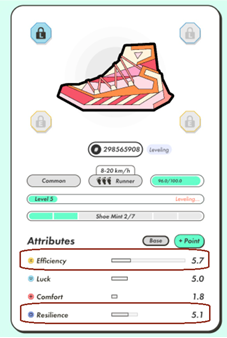
Back then, I paid about $2,000 USD for an NFT of a shoe that looked like crap. I quickly ran the numbers: running 10 min per day, each day, could make me earn $224 to $280 per week. That’s a ~11-14% investment return per week.
I know this was another tulip story, though. I had to make money fast as such a system couldn’t keep a crazy token value at $3-$4. In fact, the tokens even closed at $9 on one day. Think about it: the more you are active, the more you create new tokens (like a central bank printing money). Now that thousands of people are active on this app daily, millions of tokens are created. This flood of new tokens automatically depletes their value (as opposed to bitcoins which are limited in number).
Therefore, I made the calculations to optimize the profitability of this system (number of shoes and upgrades necessary to generate money quickly) and started running to cash my money back. I had a clear strategy with strict rules. I discovered how to open a crypto wallet, use the platform to shift from one cryptocurrency to another, and generate money by lending my coins. That was fun, but it didn’t last long…
My adventure lasted about a month. That was when I needed to get my money back and sell my shoes, as the token was crashing. Before the end of May, I had sold my shoes (I had two), cashed my tokens, and lost $100 in the adventure. Lucky for me, I got out without investing tens of thousands of dollars in shoes and upgrades. For the record, the token price is about $0.02 today and the project looks dead.
Bury them in a land far away
My final play in crypto happened before the “great collapse” when anything crypto and NFT crumbled. It happened while I had my shoes. I had another opportunity to enter a “land NFT project” where you would buy a piece of the metaverse. At that point, it was highly speculative, and I knew it. In fact, the night the project was on, we bought (my friend and I), two lands to be minted. Long story short, it’s like buying a pre-order pass for two lands without knowing what kind of digital land you would get.
Before the lands were revealed, our pre-order pass doubled in value. That was the quickest $6,000 I made in my life, I thought. But I got greedy (read stupid). I decided to keep both passes until the lands were revealed. Based on previous NFT stories I read back then, my chances of making $20,000 maybe $50,000 were pretty good. After all, if a monkey face could sell at $100,000, how much would the same person be willing to pay for the land where they could build a house for that monkey?
The Lands were revealed shortly after that, and the value of our lands fell back to our original investment value. We decided to sell one land for a small profit and keep the other one to see where it could go. Then, the great crypto collapse happened and most NFT projects and cryptocurrencies fell off like doomsday. To this date, I still own this land, but its’ value is 40% of what I paid.
Did I make any money with those plays?
You can guess I didn’t make any money from my shoes and lands. As I write this, I lost $100 in shoes and roughly $2,000 USD in lands. Fortunately, I made over $10,000 when I bought the bitcoins fund. Overall, those speculative plays kept me busy, made me dream and I made some money. Today, I have a lonely land and a small position in an Ethereum ETF left from this adventure. After I cashed my profit from bitcoins, I bought more dividend growers, funded my two other speculative projects, and bought some Ethereum ETF “just in case”. I haven’t touched crypto since I came back from Africa in July.
What did I learn?
I didn’t write this just to entertain you with my digital adventures. There are actually a few lessons to be learned from these stories.
#1 When you speculate, set strict rules. I could make money on my first trade and limit losses on my two other trades because I had strict rules of investment (how much money to invest, for how long and an exit strategy). This is valid not only for crypto, but for all investments. Never invest money you can’t afford to lose.
#2 Don’t be greedy. Again, if I had followed my rules and focused on short-term profit instead of riding the wave to make it big, I would have been richer by $6,000 today. Easy money comes in quick and disappears just as fast. You are better off cashing your profit and regret not making more money later than sitting on a paper loss forever.
#3 People make fancy arguments, but when it doesn’t generate cash flow, it’s a tulip. Use most (if not all) of your money to buy cash-flow-producing assets. Multiple tulip stories will end badly. Make sure to move fast on those because the music always stops.
#4 You probably don’t need this. Between you and me, you don’t need to speculate to become a successful investor. I use a small portion of my portfolio to speculate because I’m fascinated by numbers, and I love the game. I see speculation as a hobby, hey, as a sport! I don’t need this to reach my investment goals, or to retire. If you can’t stand losing money, then speculation isn’t for you.
***MOST IMPORTANTLY: Despite my firm beliefs in how best to grow your portfolio over time, I still enjoy brief dalliances in speculative investments with tiny portions of my portfolio. Those speculative plays are often fun and do tend to make you think “outside the box” and grow in your mental capacity.
I hope was an entertaining read and that I made you smile. It’s probably the last time you read about crypto here. Now let’s get back to what really matters: dividend growth investing!
Smith Manoeuvre Update
So far, I’m almost breaking even with my strategy. I admit that I didn’t expect much from this portfolio over the first few months. I still need to give it some time to perform (especially considering this crazy market).
I previously initiated a pause in my SM contributions. I will maintain my investment update in the coming months, but I will not add another $500 monthly for a while. My trip to Africa got out of control and I must take a few months to recover financially. When you do a leveraged strategy, you should never invest money you don’t have. I’m following my own advice. I’ll resume my monthly investments shortly, but I would rather play it safe.
Here’s my portfolio as of November 2nd, 2022 (after the bell):
| Company Name | Ticker | Sector | Market Value |
| Canadian Net REIT | NET.UN. V | Real Estate | $381.30 |
| National Bank | NA.TO | Financials | $541.98 |
| Exchange Income | EIF.TO | Industrials | $492.47 |
| Brookfield Infrastructure | BIPC.TO | Utilities | $528.84 |
| Great-West Lifeco | GWO.TO | Financials | $539.24 |
| Cash (Margin) | $2.01 | ||
| Total | $2,496.82 | ||
| Amount borrowed | -$2,500.00 |
Let’s look at my CDN portfolio. Numbers are as of November 2nd, 2022 (after the bell):
Canadian Portfolio (CAD)
| Company Name | Ticker | Sector | Market Value |
| Algonquin Power & Utilities | AQN.TO | Utilities | $6,188.28 |
| Alimentation Couche-Tard | ATD.B.TO | Cons. Staples | $22,046.19 |
| Brookfield Renewable | BEPC.TO | Utilities | $5,910.72 |
| CAE | CAE.TO | Industrials | $4,848.00 |
| Enbridge | ENB.TO | Energy | $8,537.83 |
| Fortis | FTS.TO | Utilities | $5,255.91 |
| Granite REIT | GRT.UN.TO | Real Estate | $9,088.00 |
| Magna International | MG.TO | Cons. Discre. | $5,210.10 |
| National Bank | NA.TO | Financials | $11,151.36 |
| Royal Bank | RY.TO | Financial | $7,543.20 |
| Sylogist | SYZ.TO | Inf. Technology | $3,340.80 |
| Cash | 309.13 | ||
| Total | $89,429.52 |
My account shows a variation of +$1,1702.05, (+1.9%) since the last income report on October 5th. Since there were many U.S. results this month, I’ll cover those first.
Here’s my US portfolio now. Numbers are as of November 2nd, 2022 (after the bell):
U.S. Portfolio (USD)
| Company Name | Ticker | Sector | Market Value |
| Activision Blizzard | ATVI | Communications | $8,428.56 |
| Apple | AAPL | Inf. Technology | $10,877.25 |
| BlackRock | BLK | Financials | $8,943.34 |
| Disney | DIS | Communications | $4,581.90 |
| Gentex | GNTX | Cons. Discret. | $6,046.55 |
| Microsoft | MSFT | Inf. Technology | $12,105.50 |
| Starbucks | SBUX | Cons. Discret. | $7,189.30 |
| Texas Instruments | TXN | Inf. Technology | $7,924.50 |
| VF Corporation | VFC | Cons. Discret. | $2,227.50 |
| Visa | V | Inf. Technology | $10,047.50 |
| Cash | $447.76 | ||
| Total | $78,819.66 |
The US total value account shows a variation of -$1,360.81, (-1.7%) since the last income report on October 3rd.
Apple avoided the worst.
Apple was a rare big tech to not suffer on earnings day (compared to companies like Meta and Alphabet!). AAPL pleased investors with decent growth (EPS +4%, revenue +8%) despite supply chain disruptions and continuing lockdowns in China. The iPhone topped Apple’s quarterly results with revenue of $42.6B, a 9.5% increase over the fourth quarter of 2021. Services, which include subscriptions to products such as Apple TV+, iCloud storage plans and Apple Music offerings, climbed by 5% to $19.2B. Sales in China went up by 6% while sales in America went up by 8%.
BlackRock did better than expected despite decreasing numbers.
BlackRock posted better-than-expected earnings in Q3 as higher revenue from its technology platform, Aladdin, and lower expenses helped to offset a decline in investment advisory and administration fees. Long-term net inflows of $65B in Q3 including $22.4B in ETFs, slipped from $69B in Q2. However, keep in mind that revenue and EPS fell double-digits, driven by the impact of significantly lower markets and dollar appreciation on average AUM and lower performance fees. AUM went from $9.4T in Q3 2021 to $7.9T this quarter. BLK will continue to decline if we are in a bear market. However, the upside potential for the long run is real.
Gentex is still a source of frustration.
Gentex missed analysts’ expectations for both EPS (-3%) and revenue (+23.5%). Strong sales increases were driven by light vehicle production (+26% vs last year, +22 on a quarter-to-quarter basis). Earnings fell as expenses jumped by 15% primarily due to staffing, professional fees, increased outbound freight expenses, and travel-related expenses. Still no mention of a dividend increase. I’ll be waiting for that announcement in the next few weeks. If there is no dividend increase, I’m OUT.
Microsoft shows double-digit growth, but it’s not enough.
Microsoft reported double-digit revenue growth (+11%), but EPS was down 13%. Revenue in Productivity and Business Processes was $16.5B, +9%, Intelligent Cloud was $20.3B, +20%, and More Personal Computing was $13.3B, down slightly but up 3% in constant currency. Azure sales were up 35%. It’s not the 100% we got in 2021, but it’s still solid growth. EPS was down as MSFT faced currency headwinds and saw its expenses surge by 15%, mostly driven by investment in cloud engineering, LinkedIn, Nuance, and commercial sales.
Texas Instruments faces headwinds (what’s new in the tech world?)
TXN reported double-digit growth for both revenue (+13%) and EPS (+18%), beating analysts’ expectations. Revenue increased 1% sequentially and increased 13% from the same quarter a year ago, but the company faces many headwinds (weakness in personal electronics and expanding weakness across industrial as well). TXN issued its guidance for the fourth quarter of 2022. It expects to earn between $1.83 and $2.11 a share on revenue of $4.4B to $4.8B. That outlook fell short of analysts’ estimates for TXN to earn $2.23 a share on $4.94B in sales. It’s going to be a long road of constant testing of your patience for this stock.
VF Corporation is scaring a lot of people (and I still hold)
VFC reported earnings in line with analysts’ expectations (EPS down 34%, revenue down 3.7%). VFC earnings were affected by a strong USD (sales in constant currency were up 2%) and lockdowns in China. Gross margin decreased 230 basis points to 51.4% primarily driven by higher costs and promotional activity while partially offset by price increases. Management reaffirmed 2022 guidance for revenue (+5-6% in constant dollars), but revised EPS to reflect increased negative impacts from foreign currency fluctuations and high inventory levels. Adjusted EPS is now expected to be between $2.40 to $2.50, versus $3.18 in the prior year. That information came with a small dividend increase of 2%.
Visa is just a beast
Visa reported another strong quarter with EPS and revenue up 19% while management announced a 20% dividend increase! Management also announced a new $12B stock buyback program. Strong results were driven by strong payments volumes (+10%) and cross-border volumes (+36%). Visa processed 12% more transactions this quarter vs. last year. For the full fiscal year, Visa reported revenue up 22% also driven by payment volumes, cross-border volumes, and higher numbers of transactions. Will the recession stop Visa?
My Entire Portfolio Updated for Q3 2022
Each quarter, we run an exclusive report for Dividend Stocks Rock (DSR) members who subscribe to our very special additional service called DSR PRO. The PRO report includes a summary of each company’s earnings report for the period. We have been doing this for an entire year now and I wanted to share my own DSR PRO report for this portfolio. You can download the full PDF showing all the information about all my holdings. Results have been updated as of October 5th, 2022.
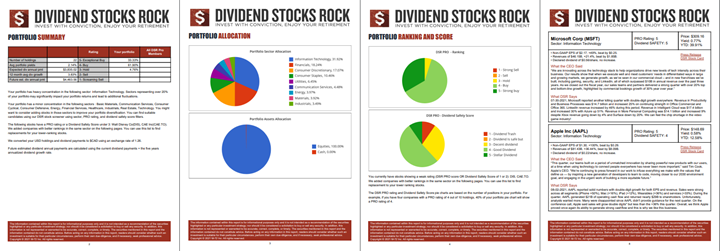
Download my portfolio Q3 2022 report.
Dividend Income: $175.36 CAD (-15% vs October 2021)
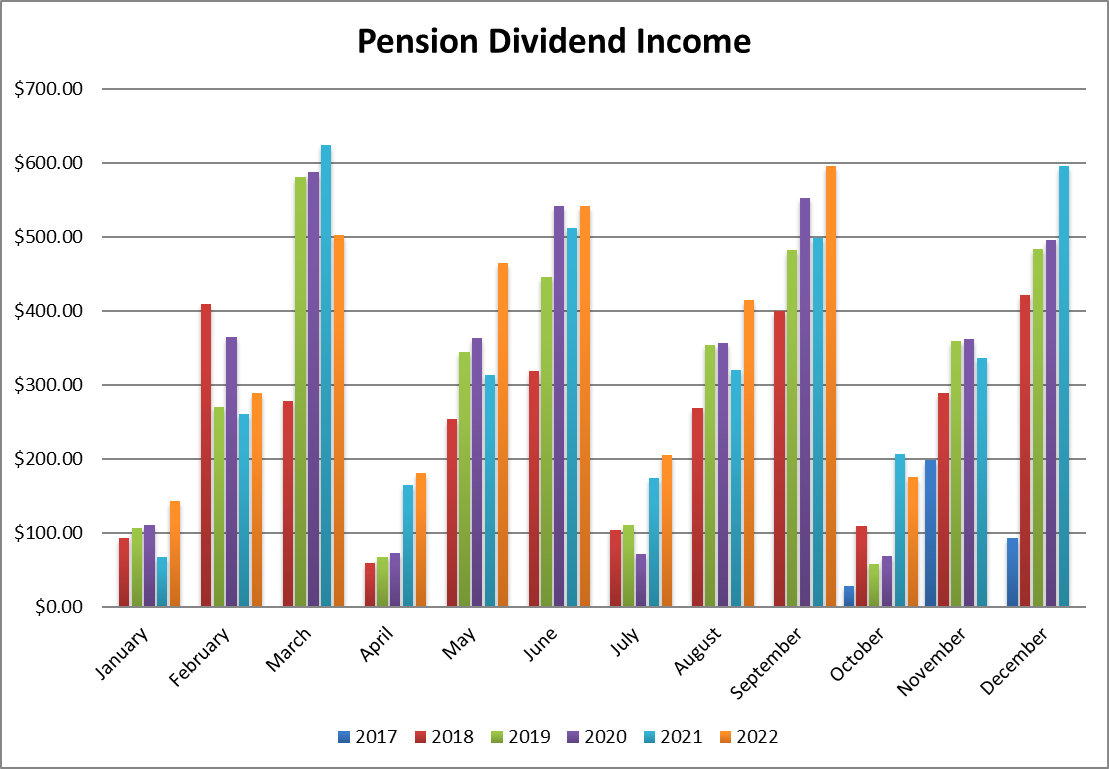
No, I didn’t suffer from a dividend cut! Last year, I had two companies paying dividends this month: Andrew Peller ($36.04) and Intertape Polymer ($64.46). I sold Andrew Peller after multiple weak quarterly results and no new acquisitions (I acquired ADW based on that thesis). Intertape Polymer was acquired for a nice profit this year.
An increase in the number of Algonquin shares plus a dividend increase from this company helped to partially offset the dividends missing from the companies mentioned above I sold. I can now also count on a $33 distribution coming monthly from Granite!
Here are the detail of my dividend payments.
Dividend growth (over the past 12 months):
- Granite: new
- Algonquin: +46% (more shares)
- Gentex: 0%
- Currency factor: +10%
Canadian Holding payouts: $136.44 CAD
- Granite: $33.07
- Algonquin: $103.37
U.S. Holding payouts: $28.20 USD
- Gentex: $28.20
Total payouts: $175.36 CAD
*I used a USD/CAD conversion rate of 1.3801
Since I started this portfolio in September 2017, I have received a total of $18,522.45 CAD in dividends. Remember that this is a “pure dividend growth portfolio” as no capital can be added to this account other than retained and/or reinvested dividends. Therefore, all dividend growth comes from the stocks and not from any additional capital added to the account.
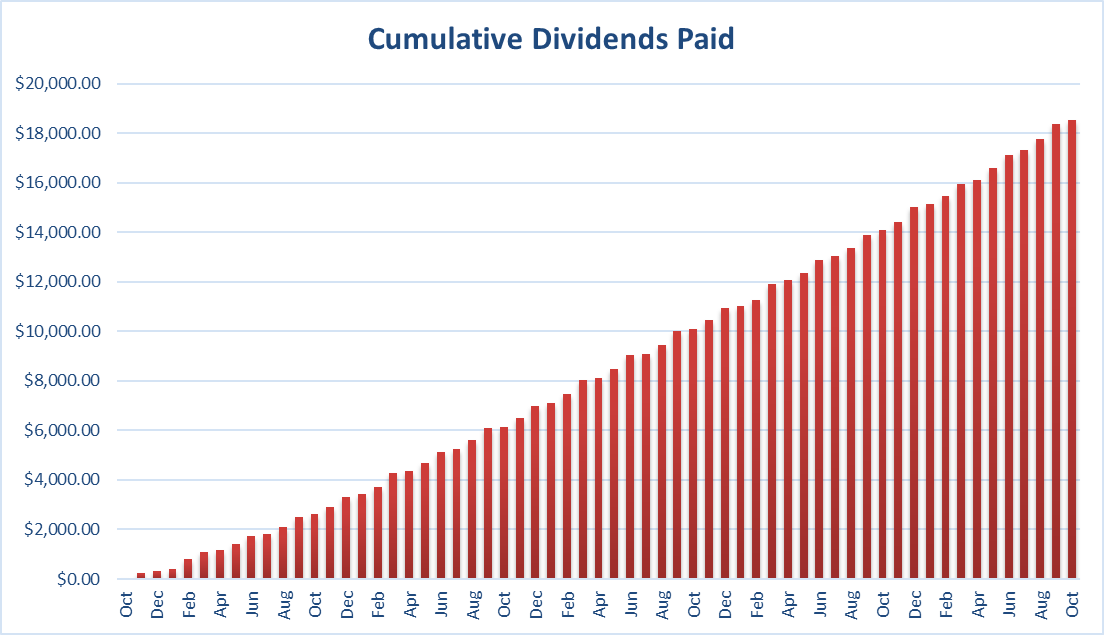
Final Thoughts
So, we are in the final moments of Gentex in my portfolio. As I mentioned in my last portfolio update, I will sell GNTX if there is no interesting news (M&A) and no announced dividend increase. So far, only a dividend increase could save GNTX from being sold especially when I look at Air Products & Chemicals with its 40 consecutive years with a dividend increase.
It’s always easier to get rid of a stock when you get excited by its replacement!
Cheers,
Mike.
The post A Tale of Shiny Objects – October Dividend Income Report appeared first on The Dividend Guy Blog.
